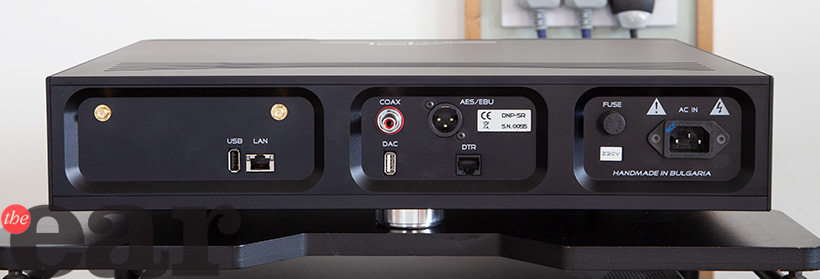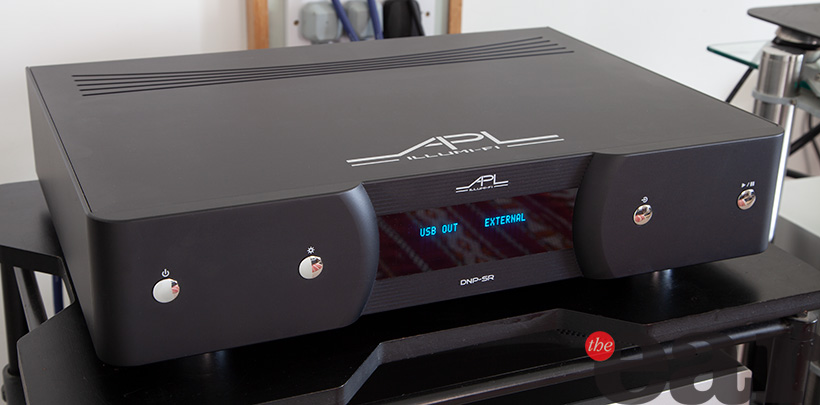APL is a Bulgarian company founded over 30 years ago by Alex Peychev. He started out in the fashion of a few other companies by modifying and upgrading products from established brands but now concentrates solely on building a range of components that he dubs Illumi-Fi. These consist of digital source components, pre- and power amplifiers and loudspeakers, many of the electronics feature tubes somewhere in the circuit but none are purely glass powered devices
The DNP-SR picks up on APL’s approach in its early days and is based on an Auralic Aries, a well regarded streamer that has the unusual feature of providing its own server software. This means that when it’s attached to network storage whether it be a USB or NAS drive or a dedicated audio library it provides the computing power to organise and playback the music files. Many streamers leave the serving part of the job to the storage device but this inevitably means that the quality of the so-called server is critical to the end result.
As APL point out the Aries is an “already outstanding product” so what have they done to improve on it. Essentially they have replaced all the switched mode power supplies found in the standard Aries with low-noise, linear power supplies and installed an oversize, hand-made power transformer. Which is a tried and tested way of improving almost any audio component but one that’s particularly effective with digital electronics. They have also used “much better” femto clocks, an area that’s less talked about than it once was, some may recall that Tom Evans started out in this game by replacing the clocks in Pioneer CD players and transforming their performance back in the ‘90s. Most digital components have decent clocks in them today but they are still key to producing results that sound natural in an analogue fashion, and upgrading what Auralic uses on its Aries Femto board clearly helps if the results produced by the DNP-SR are anything to go by.

This is a substantial lump by streamer standards, it weighs 13 kilos (over 28lbs) and is nearly 18 inches wide, it’s not the prettiest of beasts but the machined aluminium case is certainly solidly built. The display is not from Auralic and I didn’t find it particularly informative but as the streamer is controlled by Auralic’s excellent Lightning DS app there is little need to use it and in many respects displays on streamers are vestigial, they don’t need them and neither do we.
The spec here is about par for the high end course, not extreme by any means but more than adequate to the task of processing all but the most insane of sample rates. The APL copes with anything up to 32-bit/384kHz and DSD up to DSD512 in native mode, and usefully the DNP-SR is set to output native DSD by default. If your DAC can’t deal with that it can be switched to DSD over PCM (DoP) but that limits the output to DSD128.
On the connections front it’s pretty conventional too with balanced S/PDIF and USB outputs plus a dedicated DTR output for APL DACs and a USB socket for external storage drives. Network connection can be wired or wireless but APL recommend an ethernet connection to avoid jitter in the wireless option.

Sound quality
The APL was used with a Melco N10 music library and a variety of DACs. Its ethernet connection was directly to the Melco as this generally yields better results than connecting through the network switch. First impressions don’t always count but on this occasion it quickly became apparent that this is a very high resolution streamer with incredibly low noise, so much so that it sounds smoother and more relaxed than any of the alternatives that passed through the system over a three month period. Components that seemed to be pretty clean and refined ended up sounding coarse compared to the APL. It’s one of those products that proves you can always go further in the quest for maximum transparency through the elimination of electrical noise.
It revels in polished recordings such as Herbie Hancock’s version of Ain’t Necessarily So, a recording which sounds like someone found the button marked plush and kept it firmly down. Not that it’s unduly smooth, there’s lots of space and a muscular bass line to propel the rhythm, not to mention a meaty low end kick drum. This is a sophisticated recording and the APL makes that abundantly clear. Joni Mitchell’s voice on another track from this album (Gershwin’s World) is dusky like hardset honey and perfectly proportioned in image and balance terms, in all respects in fact.
The APL is particularly strong when it comes to imaging, this is a result of precise bass performance and well defined leading edges which mean that the music has a vitality and presence in the room that makes it seem very real. Room filling is the only way to describe the sound it produces with decent recordings, especially when used with the remarkable PMC fact fenestria loudspeakers. Here the streamer managed to be both calm and relaxed in its delivery and have lifelike energy, a combination that’s difficult to achieve in convincing fashion, you usually get speed and dynamics at the expense of grainy edges or, alternatively, a refined presentation that lacks drive and power. MeShell Ndegeocello’s take on Who is He (And What is He To You)? is rather good especially when her bass guitar is delivered with this sort of sinuous solidity, equally critical is that the efforts of band behind her can be easily understood and appreciated. There’s a lot going on on the track with strings, backing vocals, keyboards, percussion and more in the mix, and the APL can send it all to the DAC in totally coherent fashion. On this occasion it was the Aavik D-180 which seemed to be a particularly good fit.

I also had Aavik’s top DAC, the D-580 at one point during the APL’s tenure and this pairing was magical. Patricia Barber’s Subway Station #5 has rarely sounded so engaging and dynamic. The attack on the drums over warm guitar and Barber’s left hand building up the tension on the piano made for an intense climax. I was mesmerised by the performance to be honest, and while the rest of the system was in the same league as the streamer that element certainly took things to the next level. It has superb timing, very high transparency and contributes an urgency to live music that you don’t often get without hardened leading edges. It also works well with more relaxed material such as Terry Callier’s Lazarus which has excessive amounts of deep bass yet remained free of distortion in this set up, and when the organ comes in on Ride Suite Ride it sounds totally organic and right.
Conclusion
This streamer puts all the elements of any piece of music into balance, it reflects the recording with considerable fidelity and it allows you to hear right into the mix thanks to exceptionally low noise and distortion. Suffice to say I liked it a lot, both the quality of sound it produces and the operational niceties of Auralic’s Lightning DS control system. If you want to hear more of what’s in your digital files this APL will certainly do the trick.


